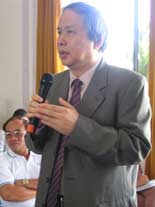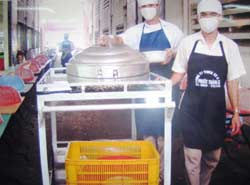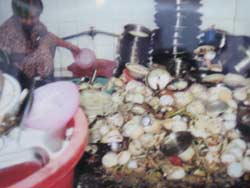Fish sauce with urea, food contaminated with growth hormones, fruits containing pesticides… Toxic substances are transmitted from the source and through the “chain” to humans.
Food safety hygiene has not been ensured, nor has it been guaranteed from the source! This was the opinion of many experts at the conference summarizing the “5-Year Food Safety Hygiene Program 2005 – 2010” held by Ho Chi Minh City on April 16.
At the aforementioned conference, many experts expressed their frustration that there is currently no mechanism to ensure food safety from the beginning to the end, where the end is identified as the consumer, meaning the users of fresh or processed food.
Toxicity in the “chain”
 |
| “Growing plants involves humans, catching fish involves humans, processing involves humans, and consumption involves humans. And any incidents that occur are also human errors,” emphasized Mr. Nguyen Nhu Giao. |
Speaking at the conference, Ms. Pham Kim Phuong, Director of the Experimental Analysis Service Center (Department of Science and Technology of Ho Chi Minh City), revealed shocking details regarding the food safety situation.
Ms. Phuong stated that almost all food samples brought to the Center for testing had “issues” concerning food safety. The Center discovered that many samples of fresh or processed food contained harmful substances for human health, such as urea, growth hormones, and pesticides.
She cited examples where many fish sauce producers submitted samples to the Center for testing protein content. The Center found that while the protein content was very high, it was actually due to excessive levels of urea in the fish sauce, not protein derived from fish.
The urea content in fish sauce sometimes accounted for several dozen percent of the tested sample.
The situation became more complicated when fish sauce producers were asked why they added urea to the sauce. Was it to increase protein content? The producers claimed they only bought pre-processed fish sauce from Phu Quoc, Nha Trang, and Phan Thiet, and brought it back to the city for further processing, but they absolutely did not add urea to the sauce!
So where did the urea come from? Further investigation led experts to the source of the fish used to make the sauce. They discovered that fish bought from offshore on large fishing vessels were not contaminated with urea due to their cold storage facilities. However, fish purchased from small-scale fishermen were contaminated with urea. The reason is that small fishing boats do not have cold storage, so fishermen must preserve fish with urea to prevent spoilage.
This source of fish, when brought back to be processed into fish sauce, was not washed. As a result, all the urea used to preserve the fish ended up in the fish sauce.
Moreover, Ms. Phuong revealed that growth hormones have also been found in chicken and pork meat.
| The average daily demand for animal products in Ho Chi Minh City is currently about 650 – 700 tons, equivalent to 460 cows, 8,000 pigs, 35,000 poultry, and about 1,600 tons of various vegetables per day.
However, the city’s livestock sector can only meet 15 – 20% of the demand for fresh animal products, while the crop sector can provide only 20 – 30% of the demand for vegetables. |
Ms. Phuong raised the issue of needing to check from the source. This relates directly to animal feed. If the feed for poultry and livestock contains growth hormones, then chickens, pigs, and ultimately the consumers will be contaminated in a “chain” reaction.
She provided an example of American companies importing shrimp from Vietnam. Every year, they send delegations to Vietnam to evaluate and control everything from breeding sites to the suppliers of medicines and even testing units like the Experimental Analysis Service Center.
According to Ms. Phuong, even the manufacturers of animal feed are not strictly monitored, leading to a floating source.
“The Department of Health should take the lead in continuing to investigate and assess the capabilities of testing units and plans for coordination. Vietnam needs to have such measures to control product quality,” Ms. Phuong suggested.
Food incidents, human incidents
Mr. Nguyen Nhu Giao, Director of Dussmann Meal Processing Company, believes that when discussing food safety hygiene, we often talk about various techniques and regulations, but ultimately, this is a product entirely made by humans. The product begins with humans and ends with humans.
“Growing plants involves humans, catching fish involves humans, processing involves humans, consumption involves humans, and any incidents that occur are also human errors. Therefore, food safety is a chain of checks where the final link remains the consumer,” Mr. Nguyen Nhu Giao stated.
He also emphasized the need to build a new generation of food consumers. If consumers refuse to accept unsafe food, then nothing can escape scrutiny.
 |
| In 2005, there were 27 cases of food poisoning with 1,536 people affected, including 11 collective food poisoning incidents involving more than 30 people. (In the photo: A standard food cart) |
Mr. Giao himself is not confident about food production processes. He explains that a production process and workers are always in a precarious situation, with unforeseen incidents occurring. This is not a machine where you can input all the necessary factors and expect it to produce a consistent product year after year.
“It is a process from input food, testing, preliminary processing, cooking, serving, cleaning, and finally waste management. No matter how skilled you are, there will always be some degree of risk involved. We have set aside a compensation amount of 1 million USD for customers in cases of force majeure,” Mr. Giao noted.
Associate Professor Dr. Le Hoang Ninh, Director of the Institute of Hygiene and Public Health under the Ministry of Health, also agreed with the statement that “food does not just go to the dining table but ultimately reaches the consumer” made by the representative of Dussmann. Furthermore, Associate Professor Dr. Ninh pointed out that the action plan to ensure hygiene from 2006 to 2010 lacks a monitoring system for cases of illness, while illness cases related to human lives are the ultimate consequence.
“We can only record clusters of outbreaks or groups of illnesses, but how can we manage or control a street vendor in front of a school when they go to seek medical attention? Meanwhile, almost all epidemics worldwide are identified through healthcare centers or practicing doctors,” Associate Professor Dr. Ninh stated.
2006: Year of Food Pollution Prevention
Ho Chi Minh City has launched a month of food safety with the theme “Preventing Food Pollution,” from April 15 to May 15.
 |
| “Assuming there is street food, and there are production facilities not meeting hygiene standards, but if society collectively boycotts them, it will certainly have a much more positive impact,” said Vice Chairman Nguyen Thanh Tai. |
Mr. Nguyen Thanh Tai, Vice Chairman of the People’s Committee of Ho Chi Minh City, emphasized that currently, on one hand, the mass media is discussing food safety issues, and facilities that do not comply with production standards. On the other hand, consumers continue to use these products as usual.
Therefore, the primary goal of the action plan to ensure food safety from 2006 to 2010 is to raise awareness and practices regarding food safety hygiene and the sense of self-responsibility of producers, businesses, and consumers.
“So assuming there is street food, and there are production facilities not meeting hygiene standards, if society collectively boycotts them, it will certainly have a much more positive impact,” Vice Chairman Nguyen Thanh Tai stated.
Experience from the avian flu shows that the public will generally avoid eating chicken when there are widespread warnings. Thus, when substandard products are announced, and consumers stop buying them, this becomes a motivation for businesses to improve themselves and for the public to become more aware.
However, Associate Professor Dr. Ninh assessed that even the primary goal of the plan, which is for 100% of consumers to understand and practice correct food safety hygiene by 2010, is an overly ambitious goal. The specific implementation to achieve this goal is not simple.
Huong Cat

















































